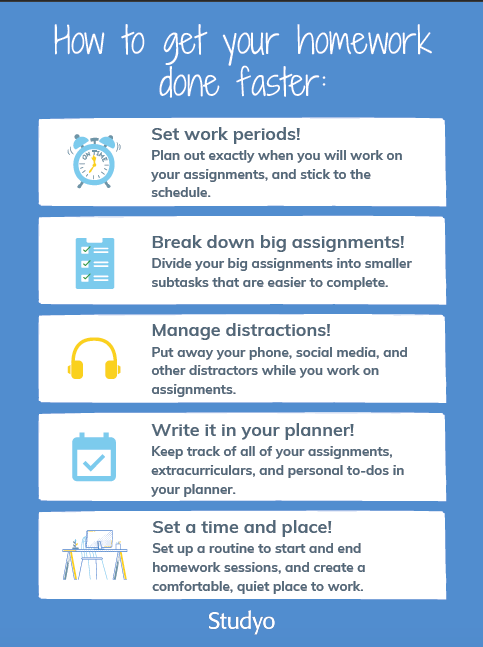December 7, 2020
(FREE printable!) 5 ways to empower students to plan
“I only slept 3 hours last night, and I’m still not prepared for the English test.”
“Ugh, at least you got sleep. I had to study for English and study the math package, all after soccer practice.”
Every educator has overheard this conversation at least once.
Naturally, because we care about students’ wellbeing, it upsets us to hear they’re working themselves so hard. At the same time, any school that expects excellence and provides a strong post-secondary prep program requires effort for success.
At a high-performing school, a rigorous workload just comes with the territory… but that doesn’t have to mean stress is a given.
Here are some ideas to empower students to take ownership of learning by properly managing their schedules.
Hey teachers: download your FREE printable classroom poster file that summarizes these organizational tips here!
Ask students to plan when they work on their day’s to-dos
Students do a lot of homework at night… but why?
Well, American high school students can get up to 17.5 hours of homework each week, or around 2.5 hours every day. Now, between part-time jobs, extracurricular activities, and other responsibilities, that’s certainly no walk in the park. But does it really mean students need to be up until 3:00 AM every night?
Teachers often puzzle on how to empower students to manage their time better when they have understandable reasons to put off homework. However, many students are self-admitted procrastinators— some will start their homework at midnight even if they have time to do it earlier.
I myself have put off some really insane piles of grading until the last minute. I procrastinated on marking tests for the same reason students delay their homework— I don’t want to feel like I’m constantly working without a break.
If students are coming from an intense practice after a long day of school, it’s not necessary to expect them to start their homework right away. Still, by planning out specific times and dates to work on each assignment, they’re less likely to have their much-needed R&R to move into procrastination territory.
Learning how to “chunk” larger tasks
“There is only one way to eat an elephant: a bite at a time.”
Desmond Tutu
Completing an essay or preparing for a big unit test can feel difficult or even insurmountable for some students. An image comes to mind of a student with an essay file open, frantically trying to reach a word limit, or— in the worst-case scenario, shrugging and saying, “I just couldn’t do it,” to the teacher on the day it’s due.
Breaking larger tasks into smaller steps benefits students in three ways:
- Setting up steps for assignments offers a more effective, organized way to approach the assignment, empowering students to succeed;
- Having multiple small tasks reduces the level of stress that one large, looming task can cause;
- It is easier for students to find time to complete smaller pieces of assignments.
Depending on your classes’ levels and needs, you can scaffold students by setting up steps for new assignments, adding dates by which to complete each task. If your students are more advanced organizers, ask them to set up their own workflow and check in to keep them accountable to their schedule!
The Cake Bake: a quick, no-prep exercise to get students thinking about the importance of chunking!
- Tell your group to imagine you want to bake a three-layer chocolate cake tomorrow.
- Ask them what steps you’d need to take— they’ll offer ideas like checking the pantry, shopping for ingredients, finding a recipe, baking the cake, etc. Take down their ideas in the order they offer them, rather than an order that makes sequential sense.
- When you’ve exhausted all the different steps, tell them you will start with the first step you’ve written on the list, and read through all of them sequentially until the end.
- When your students inevitably tell you your cake will be terrible, ask them why.
- Elicit that by following the steps out-of-order (e.g. by shopping before you choose a recipe, or baking a cake without ingredients), you will either have to redo steps you’ve already worked on, or end up with a subpar dessert.
Now you can bring it back to academics. Many of your students have been caught in the trap of seeing projects, essays, or study sessions as a two-step process— first, complete the assignment; then, hand it in. When students don’t plan out the smaller steps of their tasks in a sensible order, they end up trying to do everything at once… and they become overwhelmed or ineffective.
Empower students to deal with distractions
We hosted a webinar back in March, and I was behind-the-scenes moderating comments. Although it didn’t make it into the discussion, one teacher told a story that really stuck with me.
She had two students in front of her, and Student #1 shared that their math homework took a full 1.5 hours to complete. The teacher was surprised until Student #2 chimed in and shared that the worksheet only took them 15 minutes.
Even with learning differences in mind, that’s a pretty stark contrast. Upon further digging, Student #1 sheepishly admitted they had their phone nearby and their laptop open, whereas Student #2 was fully focused on the homework.
Student #1 could have saved at least an hour— if not more— had their full focus been on their homework. After all, multitasking has been debunked as a myth, and trying to do multiple activities at once only lowers your efficacy at both.
Although homework will always take some time (especially for students who experience challenges with their processing skills), suggest that students put the devices away, close unnecessary files/webpages, or ask them to try productivity apps and software to block distractions. They’ll actually end up with more free time to text if they do!
Get students using a planner
It’s all well and good when students plan out their schoolwork, but that’s only one facet of their lives!
Stats Canada shows that the amount of time students spend on homework and housework is climbing, and those numbers don’t even include the amount of time some students will spend on extracurricular activities, sports, and part-time work. Aside from all that, students are expected to socialize, exercise regularly, and sleep (if they can find the time for it.)
To reduce the pressure of modern teenage life, students need to be able to anticipate and plan for all their tasks— not just schoolwork! Empower students in creating actionable plans and schedules for all their daily activities.
Set up a time and place for learning
Once students set up time to do their assignments, they should choose a good spot to settle in and work. We know that students benefit from a quiet space (if not silent, then with ambient noise or music that promotes focus.) Sitting up is always preferable to lying down or slouching, and keeping all necessary materials close by can create the best possible environment to get productive.
As a teacher, you likely have transitions and routines that you use to get students in the mindset for learning. Similarly, students should develop a routine tied to starting and completing work periods for the day. Acts as simple as walking to the work area, grabbing a cup of tea, and planning out workflows prior to getting started can really put students in the right headspace for homework.
On the other hand, reviewing assignments and checking everything off their to-do list at the end wraps up the session, allows students to keep on top of their outstanding work, and helps them move into their relaxation time with reduced anxiety.
Those are our tips to empower students to take ownership of learning at home. To share these tips in the classroom, take advantage of our free printable poster files below!

Teachers: get the printable classroom poster!
Add some fresh decor to your classroom with our free printable poster file! It features the five planning tips listed in the post.
